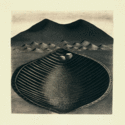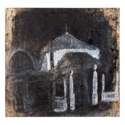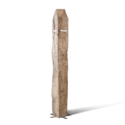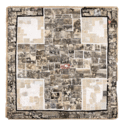
Halil Tikveša
Halil Tikveša (born in 1935, in Šurmanci, Herzegovina). He graduated from the Academy of Fine Arts in Belgrade. He has been exhibiting his drawings, paintings, graphics, collages, assemblages and objects since 1962. He has exhibited solo on 60 occasions, approximately, including: Mostar, Belgrade, Sarajevo, Warsaw, Split, Zagreb, Geneve, Novi Sad, Paris, Ljubljana, Crakow, Bradford, Lugano, Sao Paolo, Berlin, Alexandria, Fredrikstad, Biela, Ivaskilla, Heidelberg, Bonn Schur, Cittadella, Ankara, Kyoto, New Delhi, etc. He has participated in many international exhibitions and biennales. Among significant awards are: Belgrade (1964) - Award for graphics at Spring Exhibition of ULUS; Belgrade (1966) – Great Seal of the Graphic Gallery Collective; Belgrade (1976) – Award at the Third Triennial of Yugoslav Art; Sarajevo (1967) – Award for Graphics at the Exhibition of young people from Bosnia and Herzegovina; Belgrade (1968) – Award at Spring Exhibition of ULUS; Zagreb (1968) – Award at the Zagreb Exhibition of Yugoslav Graphics; Belgrade (1971) – Award for Graphics at the NOB Exhibition in the works of artists of Yugoslavia; Belgrade (1974) - "Golden Needle" at Spring Exhibition of ULUS; Belgrade (1976) – Award for Graphics at the 27th October Showroom; Skopje (1981) – Award for Graphics at the 7th Exhibition of artists of Yugoslavia; Ljubljana (1981) – Auction Award, at the 14th International Graphics biennale.
--------------------------------------------------------
Emanations of things- raptures of the living – life:
The works of Halil Tikveša ------------------------------------------------------
Formerly when, Halil Tikveša, bid his findings with his graphics to us, now already in the bygone sixties and seventies, these actually being experiences and spectacles of the south (South Herzegovina) – south as the motive of light but also as the motive of peculiarity and existence, having those graphics in hand, we might experience what we strive to undergo afore of every intrinsically, vigorously, trustworthy artistic work or marble such as the artwork of Tikveša. As such (here fine work, respectively graphics), in his unexampled author's language, unfolds the dimensions of a world and life which normally eludes us, remains unobtainable to our sketchy, superficial, quotidian eye. The glance of Tikveša's eye, which is both intrinsic and extrinsic, with only his sensitive perceptive and receptive sensors, emerging in a light living being of the south, bearing with the plentitude of that world's experience (consisting of both natural pageants of forms, artifacts and life-vital human experience sets) – gaze which is carried by the strength and depth of adventurous and emotional encounter with mundane and celestial scenery of the southern light, land and water. It leads him towards his creative transformation of such ballast, towards his materialization in the graph paper as an originated reality per se, and as such an originated world order (a reality of a different exponent, reality which lies within a body and language of the artistic work) has its own and his new ontology. Hence – despite the fact that the epigraphic and empiric horizon of Tikveša's initiative cycle, represents the reality of the south as a natural and vital environment – his graphics do not deal just with mere mimic representations of chosen scenery nor just with mere narrative notions.
Tikveša's graphic interpretation of the "realistic paradigm", in its intention, its performance and its product – represents a unique visual art (graphic) phenomenology, in the sense in which Tikveša (in the perception process and in the perception process of content transposition and materialization on the graph paper) , scenes, items, beings or phenomenon focuses on, literally, their phenomenon essence, in plane pith of their fundamental form, but (simultaneously), focuses on dense layering of their meanings and their symbolic capacity. In such sense, Tikveša truly does not care about any kind of literal narration, or any mere tautological depiction (peculiar to simplex mimic methods).
On the contrary, he seeks and discovers intrinsic, fundamental properties of the perceived body, scenery and their structural elements. He separates them, sets them as clear compositional, spatial, audio or light sequences on graph paper, with his own perceptual strategy in the stream of stimulants and phenomenon. In other words, Tikveša submits the concerned realistic content to a kind of a process of reduction to what is essential, to the intrinsic formal (but likewise to an eventful, existential and intellectual) value - thus, forming its basic formal (also symbolic) index whom he deals with, making pictorial, artistic and visual configuration of the respective graph paper. In the natural sights and scenery of Herzegovina landscape, Tikveša's view focuses (as a kind of a constant, or, if I dare to say, as a kind of a "trademark"), on conical profiles of rocky hills or on wavy lines of their sequences as he generally, in aspects of his drawing procedure, uses a rich, plastic curve capacity with its dynamic values, as well as abundant, and balmy form edges.
That conical form - or curve - within the entire scenery, typically is placed in a complementary distribution with curves (along with their dynamics) of other elements of the respective graphic plane (with soil curve, water plane dynamics and the respective body).
Tikveša's graph paper, both formally and substantially, (graphically and pictorially), represents utterly a pure, consolidated, plain (and simultaneously) expressively, unusually, a vigorous artistic event and a, inherently, crystal clear completed unit. ---------------------
Sulejman Bosto
(Part of the text, published in Sarajevo Notebooks; Issue no. 23/24, 2009.)




































































































